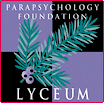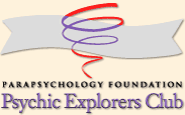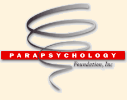 |
 |
| Click here for the PF Lyceum Site Index
By Andrea Fodor Litkei PF Lyceum Blog #31 Posted March 21st, 2012 My father, Dr. Nandor Fodor, devoted the better part of his lifetime for the missing answers that might give a more complete picture of the whole of man and the phenomena that occurred around him, and in connection with him. He did supply some of the answers, in his pioneering researches—but before I continue—one can talk about a man but not for him. So first, I would like to give you some of his own words as to give you a taste of his personality and outlook on these matters, before I go into the biographical fact and details of some of his researchers. To quote him; “In a lifetime of adventure and research I would feel hard put to answer the question as to what has enthralled me most. It appears to me that in the wonders of the human mind no scale of comparison exists. Time, place and mental disposition are the decisive factors in fascination. There is enough to choose from for the most delicate taste. The reach is open from Heaven to Hell. Ample room exists for every kind of approach; the psychological, the philosophical, the psychoanalytical, the occult and the religious. I have no drums to beat, no isms to serve. Like Lewis Carroll’s child, ‘with pure, unclouded brow and gleaming eyes of wonder’ I sat before the unknown, sailed into it, for the best years of my life. I can truly say that my three score and ten years have been marvelously lit up by the excitement and unceasing wonder of this quest.” These words were written a few months before he died, three score and ten, in l964. He set about this quest—“great adventure”—as he liked to call it through force of life circumstances, which resulted in putting him in a unique position within the two disciplines of parapsychology and psychoanalysis. Firstly, he was a lawyer—he received his doctorates, LLD and PhD, in philosophy, at the Royal Hungarian University of Science of Budapest in l917. He became a well-known journalist, and he as Director of the International Institute for Psychical Research, l935-l938, in London, a psychic researcher. Finally he became a respected psychoanalyst fully equipped to try a case—write about it—investigate it and analyze it according to each of his professions, the knowledge of which, he retained throughout a lifetime. It was a rare combination! Although psychoanalysis was the profession that finally claimed him, he never lost the insights which the other three had given him. As a parapsychologist, he admitted to three paranormal cases that he would willingly take to court and defend as a lawyer. So when the Editor of Modern Mystic asked him to do so, he accepted the challenge and out of the many picked “The Pearl Tie-pin Case” reported by Professor William Barrett, Professor of Physics, Royal College of Science, Dublin, in his book The Threshold of the Unseen the case supported by Sir Oliver Lodge, world-famous physicist: “The Hugh Lane Case”; his communications after having drowned aboard the Lusitania (also reported by Barrett) and the “Oscar Wilde” communications which came through the highly cultured Hester Dowden, daughter of Professor Edward Dowden. She was also the medium in the other two cases. The latter two are not as strong as the first but as supporting evidence could not be denied a hearing in a court of law. As for his personal experiences, he could not look back on more than three occasions (in a lifetime) which were evidential enough for him to consider survival of the human personality after death, a definite possibility. Happily, through not accepted by science today as William James, the great American psychologist said: “ One white crow is sufficient…to prove that not all are black.” His journalistic talents are evidenced in his many books, fourteen and innumerable scientific articles and only he, as a psychoanalyst, could possibly hint at the ideas. I quote from his book The Haunted Mind “that the delusions of the paranoid in blaming others for his feelings are not necessarily unfounded, and that some of his delusions may arise from the chaotic emergence into the conscious mind of uncomprehended telepathic impressions.” The transition from psychoanalysis to parapasychology is an easy one—a logical one, but not too many have taken the steps. The father of psychoanalysis, Sigmund Freud, did, when he published, albeit cautiously, a paper entitled, “Telepathy and Dreams”, in l922. “Psychoanalysis and Telepathy” published posthumously in l941 caused a sensation since Freud had strongly committed himself for the possibility of telepathy. The meeting between my father, Dr. Nandor Fodor and Freud, is now psychoanalytic history. When Freud learned of the impasse that had developed between the International Institute for Psychical Research in England, and Dr. Fodor (then the Director of the Institute) because of his lone championing of the psychoanalytical approach, Freud was aroused and asked to see the controversial manuscript On the Trail of the Poltergeist, Fodor: Citadel Press, NY l958. On November 22, 1938, Freud wrote a letter in German in his own hand to Fodor, which has been published in English translation in its entirety in Ernest Jones’ The Life of and Work of Sigmund Freud, Basic Books, l954, and in The Haunted Mind, Fodor, Helix Press, Garrett Publications, NY l959. To quote one paragraph from the letter, which paragraph is really the crux of the matter: “The way you deflect your interest from the question of whether the phenomena observed are real or have been falsified and turn it to the psychological study of the medium, including investigation of her previous history, seem to me the right step to take in the planning of research which will lead to some explanation of the occurrences in question.” This is what parapsychology is all about, explanations—which ever way we can come by them. It is all very well and necessary to verify whether the phenomena do happen, whether they can take their place in the ordered happenings to be scientifically investigated. However, the chaff is not only thrown out with the wheat when only psychic researchers or parapsychologists, in the strictest sense of the word, take over, but the fantastic workings of the human mind, the subject which produces the object paranormal phenomena, or has a relationship to it, is ignored and the object alone is worked over, turned inside out and then discarded to be investigated at some future, nebulous date, unless some explanation of it is immediately forthcoming. How much valuable knowledge of the workings of the human psyche has been lost on the way; knowledge that might well lead to the explanation of the psychic phenomena in question anyway, and answers to the human problems that confront us be merely a by-product. By now we should know that everything is interconnected. A web was woven in the dimly lit archaic past that bind all to all even though we have but a glimmering of the threads that bind them, and most we see not at all. How then can one separate the phenomena from its surroundings? Freud knew this and took the plunge, though much against the consensus of opinion of his colleagues. My father did the same and was attacked and libeled by an outraged group of spiritualists and psychic researchers, in spite of his theories being upheld by no less a personage than Freud himself. The gap between psychoanalysis and parapsychology has been lessened somewhat by outstanding analysts such as Emilio Servadio, Jule Eisenbud, Jan Ehrenwald, Joost Meerloo to mention a few, but the resistance is great. It is understandable. Psychoanalysis has long last achieved the standard of an accepted science. Parapsychology is only in the process of being accepted as one. To give an example of this resistance: innumerable books and articles in research and popular journals have been written on poltergeist phenomena since l958, postulating ghosts, departed spirits (the most popular theory) and telekinetic or psychokinetic phenomena as possible lines of investigation. Not one has made reference to Fodor’s theory, that such phenomena could be the physical result of unresolved tensions in the people who witnessed them, or his definition of the poltergeist as “a bundle of projected repressions,” quoted by the New York Times, May l958. Why? Are the parapsychologists afraid that analytical investigation may cause a “dematerialization” of their projects and theories? Many mediums, in fact most, will not subject themselves to psychoanalytic investigation for fear of being “cured” and finding their powers vanished thereby losing their material or artistically creative raison d’etre. But this is not so. A neurotic concert pianist will not lose his inborn talent and hard-acquired ability through the course of years, only his neurosis. This example may be objected to since many may say that mediumship or any other paranormal talent is the result of neurosis. Again, not so. Training would then have no effect, in fact would aggravate the neurosis which it does not do, it does just the opposite, serving as a release and saving the subject from a possibly more drastic neurosis. By the same token the majority of psychoanalysts are also laboring under the false impression that if they should so much as lay a foot on psychic ground, let alone admit that a vast territory exists, they would be labeled mystics and have to bear this stigma along with C.G. Jung, who being the giant that he was, could take it with equanimity, but could they? For those who have not read Ernest Jones’ Life and Work of Sigmund Freud, or various other papers wherein it is mentioned, it may come as a surprise to know that Freud, Ferenczi and C.G. Jung had many Parapsychological get-togethers, experiences and discussions, so much so that Freud in a letter to Hereward Carrington (published in Jones” Life and Work of Sigmund Freud) stated that, “If I had my life to live over again I should devote myself to psychical research rather than psychoanalysis.” My father reversed it. He started with psychical research and ended up with psychoanalysis. Till the end of his life his goal was to reconcile the two disciplines. To that which parapsychology has no answer perhaps psychoanalysis has and vice a versa. The two are intertwined whether we like it or not. In fact, we are changing it again to psi research, necessitating an explanation to the uninitiated, every time that it is mentioned, that we are not talking about “sigh”, but psi and must, perforce, spell it for them to make sure they know what we are talking about. I fail to see what is wrong with a nice big-sounding name like parapsychology, which at least, brings a personal connotation into it, but since everything is now abbreviated and heading for the lab and impersonality, we must pay our penance to science and swim along with the tide since laboratory statistical, computerized research is very necessary. The polarity with which our universe is seemingly blessed, demands two sides to every question—In this case, the personal and the impersonal. The effect must be established independently of the cause, regardless of its relationship to the effect. But research cannot end there unless it is to be left with one side of the coin. The answers are invariably derived from the matrix, but the Mother of All Things is often so well hidden that we must start with the offspring in the hope that it will lead us to the primary causes. Phenomena are the effects, and parapsychology is well nigh in danger of becoming bogged down in them. The lab offers a tremendous contribution in proving that these effects do exist objectively, but in the eagerness of the researchers to prove that parapsychology is fit to join the ranks of the sciences, the human equation is being all but lost. Good mediumship is a vanishing phenomenon. The main reason for it is that the phenomena produced by the medium cannot be repeated at will and transferred to graph paper. Understandably, the pressures of scientific demonstration have forced the researchers to, more or less, abandon this side of research. And here is where the psychoanalyst comes into his own. Nothing can be put over on him because, for him, fraud itself is a phenomenon that justifies further investigation. His prestige is not at stake and by his profession he is bound to continue the investigation further. He then may come up with some answers to the many puzzling questions. The history of psychic research has proven that not all is fraud nor all is genuine. Our necessary insistence on the repeatable experiment has done much to cause an impasse in parapsychology. And yet we are faced every day with many instances of the un-repeatable experiment not cancelling out the fact that the original phenomena undeniably exist. We dream, but we cannot repeat a dream at will, or for that matter, even choose the subject we wish to dream about. However, nor can psychoanalysis do without the help of the other sciences. Witness the biochemistry experiments with schizophrenia. Psychoanalysis is able to alleviate but not cure schizophrenia. The New York Times, May 25, l968 reported “Evidence gathered in three laboratories indicates that a substance found in excess amounts in the blood of a majority of schizophrenic patients may be responsible for the bizarre symptoms of this chronic mental disease. (Since then only new pills have been discovered.) Of course then, we come to the question of why does this substance manifest itself in excess amounts in the blood of a majority of schizophrenic patients? Is the mind responsible, is it the prima causa, or the body? This again is a subject for future biochemical and analytic research. More and more we have discovered that the physical cannot be separated from the psychical, no matter how much easier the task would be, and no matter how much we would like it to be so. Every science will eventually be interrelated; they cannot remain in their respective niches. An interesting question concerning survival posed by C.G. Jung is related in Miguel Serrano’s book C.G. Jung and Herman Hesse, Schocken Books Inc., NY, l966: “You know of course, that a small child has no clearly defined sense of the Ego. The child’s ego is diffused and dispersed throughout his body. Nevertheless, it has been proven that small children have dreams in which the Ego is clearly defined, just as it is in mature people. In these dreams, the child has a clear sense of the persona. Now if from a physiological point of view, the child has no Ego, what is it in the child that produces these dreams, dreams which, I may add, affect him for the rest of his life?....If the physical Ego disappears at death, does that other Ego also disappear, that other which had sent him dreams as a child?” Here, again, is a problem belonging to the investigations of a psychoanalyst, but more than bordering on the shores of parapsychology. The phenomena of astral projection properly belong to both disciplines. To psychoanalysis, the investigation of possible dissociation of the personality and to parapsychology the verifiability of the objective happening. The two disciplines cannot be divorced. Freud foresaw this way back in l922 when, much against his will, he was forced, contrary to his own scientific yearnings, to admit the possibility of telepathy as an objective fact. Jung gave a new name to coincidence and called it synchronicity, enabling this phenomena to come under the scientific eye, though not too much has been done about it, but, no doubt, it will force itself upon the attention of the researchers by its sheer weight of numerical happenstances. In the last analysis, parapsychology and psychology are really not more than Man trying to find out whether he is more than he thinks he is, and if so, how to relate to this illusive objective. If, for the moment, he is not more, the fact that he has been endowed with the ability to envision this possibility at all, denotes a potential—a potential that he might become the Being of which his mythology has hinted through the centuries; the mythology that has haunted his soul with the promise of its fulfillment. I can do no better, to close the circle of the common ground between Freud and Fodor, than to quote from my father’s book The Haunted Mind: “The addition of the psychoanalytic method of approach promises a greater understanding of psychic manifestation than the exclusive utilization of objective methods of research, as used in parapsychology and psychical research. These disciplines must work hand-in-hand, lest the conquest of great mental realms be postponed to future generations.” In closing permit me to share with you a poem I wrote entitled Lament dedicated to my much beloved father. My father, my father I loved you, my father, And now you are dead, Yet I love you the more. I need you, I need you, My father, my father, But long are you fled Down the last corridor. You hear me? My father— A daughter is calling. Or doesn’t that count Anymore where you are? I wonder, I wonder, My father, my father, How near is the Fount That you searched for so far! You spent a whole lifetime, My father, my father, In probing the Soul Of such mortals as we, And now it’s the nightime (I love you my father) To show us the Goal, But you can’t answer me. One evening I dreamed that I hear you, my father, But dreams are not real, At least that’s what they tell, But you never thought so, My father, my father, And strangely (I feel) I could hear you so well! Andrea Fodor Litkei is an author, poetess, artist, musician and daughter of famed psychical researcher, journalist and psychoanalyst, Dr. Nandor Fodor. |
 |

|
 www. parapsychology. org |
||